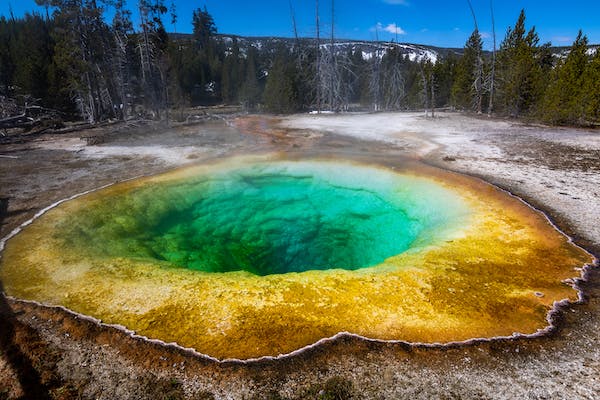A spring, whose center reaches 199 degrees Fahrenheit (93 degrees Celsius), is well-known for its distinctly fascinating, multicolored appearance. From the center, it scales to turquoise and blue hues, but as it reaches the perimeter, bacteria clusters around the sides because they are cooler than the center and reveal warmer colors. This spring is named the Grand Prismatic Spring and can be found at the Yellowstone National Park.
Established in 1872, the Yellowstone National Park has had nearly 4.1 million visitors each year. From the spring as mentioned above to geysers, a Grand Canyon and grizzlies, the Yellowstone National Park is reputed for more than just its natural wonders, but also for being America’s and the World’s first true national park. Residing in this park are over 10,000 hydrothermal features, such as fumaroles, mud pots, and hot springs, and more than 500 active geysers, which is more than 50% of the world’s geysers.
The park is located in Wyoming, Montana, and Idaho in the western United States of America. Wyoming has most of the park at 96%, followed by Montano, which has 3% of the place, and Idaho with 1%. It is about 3,472 square miles or more than 2.2 million acres; thus, it is larger than Delaware and Rhode Island combined.
Years before its founding, wildlife and its habitat were taken great advantage from and were seemingly and irresponsibly exploited for personal and selfish gains. But because of naturalists and activists like John Muir, the cry for protection, security, and sustainability of nature had reached the government’s upper levels. Former President Abraham Lincoln responded to the concern by placing Yosemite under California’s protection.
However, in 1872, former President Ulysses S. Grant made the Yosemite National Park the first true national park. This was in the request of Ferdinand V. Hayden, a geologist who surveyed the area. Along with his appeal were the photographs and paintings of people he asked helped from, to show the leaders that Yellowstone was worth giving attention to. Many who had viewed those photos and paintings today remark that it’s as if it was not more than a century and a half passed by; it still looked quite as when it was first established.
Yellowstone has five main attractions: Old Faithful Village, Grant Village, Lake Village, Canyon Village, and Mammoth Hot Springs. Each has a distinct geographical or geological feature.
Old Faithful Village is known to be the park’s largest cluster of visitor services. It is here that the Old Faithful Geyser erupts about 130 feet high and 17 times per day. To know more about these geothermal wonders, travelers can step in the Old Faithful Visitor Education Center. The Upper Geyser Basin and the Firehole River can be found in this area, where 60% of the world’s geysers are located. Also included in Old Faithful Village are the Midway Geyser Basin, Grand Prismatic Spring, and Lower Geyser Basin with its Fountain Paint Pot.
Grand Village has a visitor center, several stores, a boat ramp, a gas station, and an amphitheater with Summer Ranger programs. At the same time, Canyon Village houses the Grand Canyon of the Yellowstone, arguably the park’s most breathtaking attraction. Yellowstone Lake is the most extensive high elevation of North America.
The Winter is no hindrance to the fun that takes place in the Yellowstone National Park. From snowmobile tours that take visitors across Yellowstone’s marvelous winter wonderland, to Snowshoeing and Cross-Country Skiing, to Dog Sledding with a pack of resilient and robust sled dogs. Ice fishing is also an activity that the fishing beginner or seasoned veteran can enjoy in this park. The Grizzly and Wolf Discovery Center gives its visitors, both young and old, the unique and exciting experience to see with their very own eyes these majestic predators.
Found in the Yellowstone National Park are 67 species of mammals, including the Badger, Black Bear, Bobcat, Cougar, Coyote, Gray Wolf, Grizzly Bear, Marten, Red Fox, Long-tailed Weasel, River Otter, Wolverine, Bison, Bighorn Sheep, Elk, Mule Deer, Mountain Goat, Moose, White-tailed Deer, Pronghorn, Beaver, and Red Squirrel. This is the largest concentration of mammals among the lower 48 states. Meanwhile, for birds, there are 285 species with 150 nestings. Examples of birds found in the park are the Golden Eagle, Bald Eagle, Osprey, Peregrine Falcon, Trumpeter Swan, and the American Dipper. The park has 1,800 archaeological sites, 1000 miles worth of hiking trails, and 290 waterfalls.
A trip to the Yellowstone National Park is not only a journey to one feature but several heartwarming, life-changing, and thrilling activities and attractions. From getting a glimpse of the mighty Grizzly to marveling at and for geological wonders, one can get so much from the first true National Park of the World.

